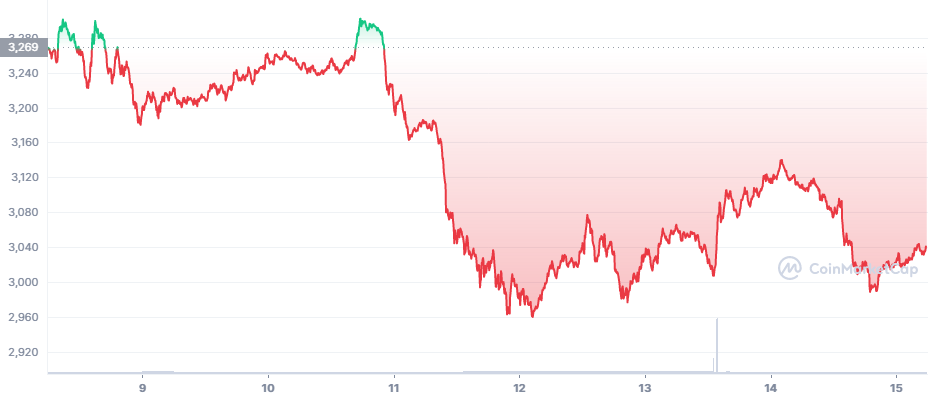Ethereum (ETH): Delaying ETH 2.0 Again

Ethereum (ETH) has a long-standing drive to become a proof-of-stake coin. But over the years, the goal has been shifted forward, lately being seen as potentially unrealistic. Some of the obstacles include pressure from miners who find the blockchain lucrative. Other problems include the inability to implement a form of side chains to offload traffic.
Since 2017, Ethereum had several hard forks to slowly phase out mining. The rising price of ETH made the block reward more lucrative, and there was no cap on token production. Additionally, ETH 2.0 smart contract was built to encourage preliminary deposits. Currently, more than 11M ETH are locked, waiting for the launch of staking.
The staking requirement for ETH is relatively high, locking in 32 ETH with no recourse to withdraw until the launch of staking. Some of the assets locked were deposited at much lower prices and may actually be sold rather than staked.
Despite the locked funds and the burning of ETH for fees, the supply remains above 120M, higher than previous suggestions production would almost freeze at around 90M ETH.
What ETH 2.0 Promises to Achieve
The chief idea of ETH 2.0 was to ensure lower fees and transaction scaling. Recent talk from developers, however, has signaled that the technology may not deliver as promised. In fact, the event has been rebranded as a “merge”, where mining and staking may coexist.
Skeptics see the failure to achieve the promised structure as a great risk for the price of ETH. For some, the actual ETH 2.0 will probably never arrive and may be an impossible achievement with current blockchain technology.
The true speed of ETH 2.0 with low fees may only come after a rework of the consensus protocol. However, recent dev calls suggest this technology is nowhere near ready.
Currently, ETH relies on consensus of multiple distributed nodes, often counting above 10,000. Full nodes as a service are rare and in fact most nodes do not contain the full blockchain history.
Some forms of fast consensus require delegated proof-of-stake, where a smaller number of dedicated operators sign transactions. The minimal number of staking nodes is seven, to avoid impersonation attacks. Most networks relying on this structure require between 21 and 100 nodes, with more nodes for sale in some cases.
On the optimistic side, a success for ETH 2.0 or at least no more delays and a partial launch may trigger an ETH rally and drive prices to a long-awaited high of $10,000.
What are the Problems of ETH 2.0
The problem with ETH 2.0 is that the Ethereum network carries more than $110B in notional value. Additionally, various protocols have created thousands of regular tokens and NFT items. All of those assets will have to migrate in a way that precludes duplication.
So far, Ethereum has not managed to achieve shards or other ways of parallel off-chain computation. One way to make it look like ETH 2.0 is achieved is to build a new proof-of-stake network, which can be compatible with the mined network. This, in effect, will be like Ethereum rebuilding projects like Polygon. Unfortunately, parallel and compatible networks have one great risk – bridging assets through smart contracts that may have unexpected potential for exploits.
The other problem is that miners may continue with their own blockchain history, essentially duplicating all the tokens and creating confusion.
The other problem with various forms of proof-of-stake is that even new networks have shown signs of congestion and higher fees when usage rises. Avalanche (AVAX) saw a significant temporary rise in fees. For now, Solana and Polygon remain some of the networks with constantly low gas fees.
How ETH Prices are Moving
Despite the news of another delay, ETH 2.0 is no big news anymore. ETH stood at $3,040.06 late on Thursday, stepping back from levels above $3,500. ETH was also affected by another Bitcoin (BTC) dip threatening to go under $40,000.
The dominance of ETH is relatively high at 19.5%, as the asset has other locked up balances in DeFi protocols. ETH is also mostly flowing out of exchanges and is wrapped in several other blockchains, as a basis for decentralized trading. The supply of ETH is showing signs of long-term holding.
Market signals show that with 72% of traders in the money, ETH is showing bullish expectations.
ETH has the advantage of a more liquid market, hence its usage as a base asset in other protocols. Even new networks resort to wrapped ETH (WETH) for its more reliable valuation.

Uphold makes buying crypto with popular currencies like USD, EUR and GBP very simple with its convenient options to swap between crypto, fiat, equities, and precious metals.

With over 50 coins and an obsession with security, Kraken is one of the safest places to buy and trade crypto.

Kraken has a good reputation for security and protection of your funds and operates across the USA (except NY), Canada, the EU and Japan

Based in Charleston, South Carolina. Serves over 184 countries and has done over $4 billion in transactions. Offers convenient options to swap between crypto, fiat, equities, and precious metals.

Will decentralised finance revolutionise the financial world or is a a lot of hype. Should you get invoved?

What are the most common scam coins and how much have they got away with in the past, plus some tips on how to avoid these scam coins.

The leader in programmable money, smart contracts and decentralised applications. There have been many copycats but none have the community and level of adoption.

An early alternative to Bitcoin, LTC aimed to be a coin for easy, fast, low-fee spending. LTC offers a faster block time and a higher transaction capacity in comparison to Bitcoin.